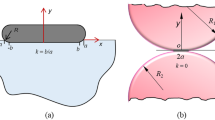Abstract
Isochromatic patterns in the vicinity of frictional contacts furnish vital clues for characterizing friction. Though friction effects are evident in a diametrally loaded circular disk, three-point loading provides better results towards highlighting friction. In this paper, a new method of characterizing friction at loading contacts using photoelastic isochromatics patterns is presented. Location of isotropic points (IPs) formed in three-point and four-point loadings of circular disk is used as a main tool to quantify the friction component using theoretical analysis. Bifurcation of isochromatic fringe loops near the distributed loads is explained by the presence of anti-symmetric Hertzian shear traction in addition to Hertzian normal traction. The classical solution by Flamant for point load at the edge of half plane is used to derive stresses in circular disk for all required loading configurations. A semicircualr ring under three-point loading is examined using photoelasticity to understand the isochromatics pattern theoretically by considering normal and shear traction components at loaded regions.




























Similar content being viewed by others
References
Dally JW, Chen YM (1991) A photoelastic study of friction at multipoint contacts. Exp Mech 31:144–149
Uemura Y, Takai M, Takemura K (1950) Measurement of the coefficient of friction by the photo-elastic method (I). Technical report, Institute for Chemical Research, Kyoto University. http://repository.kulib.kyoto-u.ac.jp/dspace/bitstream/2433/74201/1/chc023_052.pdf
Uemura Y, Takai M (1952) Measurement of the coefficient of friction by the photo-elastic method (II). Technical report, Institute for Chemical Research, Kyoto University. http://repository.kulib.kyoto-u.ac.jp/dspace/bitstream/2433/74373/1/chc027_050.pdf
Comninou M (1976) Stress singularity at a sharp edge in contact problems with friction. J App Math Phys 27:493–499
Burguete RL, Patterson EA (1997) A photoelastic study of contact between a cylinder and a half-space. Exp Mech 37:314–323
Fedorchenko IM, Kovynev RA, Makovetskii VA, Sitnikov LL (1968) A photoelastic technique for examining contact stresses in powder compaction. Poroshkovaya Metallurgiya 71:850–854. translated version
Barbat SDK, Rao RS (1990) Photoelastic investigation of metal-forming processes using new sapphire dies. Exp Tech 6:40–43
Foust B, Lesniak J, Rowlands R (2011) Determining individual stresses throughout a pinned Aluminum joint by reflective photoelasticity. Exp Mech 51:1441–1452
Cheng-yao G, Jia-fu Q, Nan-sheng Q, Guo-chun Z, Hou-he Z, Qiao Y, Xiang-dong B, Chao W (2013) The relationship between the friction coefficient and the asperities original inclination angle. Res J Appl Sci Eng Technol 6(11):1906–1910. http://maxwellsci.com/print/rjaset/v6-1906-1910.pdf. Accessed 9 March 2014
Frocht MM (1941) Photoelasticity, vol 1. Wiley, New York
Ramesh M, Kailas SV, Simha KRY (2008) Near surface stress analysis strategies for axisymmetric fretting. Sadhana 33:273–297
Timoshenko SP, Goodier JN (1970) Theory of elasticity, 3rd edn. McGraw-Hill Book Company, Singapore
Little RW (1973) Elasticity. Prentice-Hall Inc., New Jersey
Johnson KL (1987) Contact mechanics. Cambridge University Press
Coker EG, Filon LNG (1957) A treatise on photo-elasticity. Cambridge University Press
Michell JH (1900) Elementary distribution of plain stress. In: Proceedings of the London mathematical society, vol 32, p 44
Mindlin RD (1937) Stress systems in a circular disk under radial forces. J Appl Mech 1:41–44
Ma C-C, Hung K-M (2008) Exact full-field analysis of strain and displacement for circular disks subjected to partially distributed compressions. Int J Mech Sci 50:275–292
Surendra KVN, Simha KRY (2013) Synthesis and application of weight function for edge cracked semicircular disk (ECSD). Engng Fract Mech 107:61–79. doi:10.1016/j.engfracmech.2013.05.010
Dini D, Hills DA (2009) Frictional energy dissipation in a rough hertzian contact. J Tribol Trans ASME 131:021401–1–021401–8
Ayatollahi MR, Mirsayar MM, Dehghany M (2011) Experimental determination of stress field parameters in bi-material notches using photoelasticity. Mater Des 32:4901–4908
Mirsayar MM, Samaei A (2013) Photoelastic study of bi-material notches: effect of mismatch parameters. Eng Solid Mech 1:21–26
Mirsayar MM (2013) Calculation of stress intensity factors for an interfacial notch of a bi-material joint using photoelasticity. Eng Solid Mech 1. doi:10.5267/j.esm.2013.09.006
Zakeri M, Ayatollahi MR, Guagliano M (2011) A photoelastic study of t-stress in centrally cracked brazilian disc specimen under mode II loading. Strain 47:268–274
Murthy NS, Reddy PV (1987) A manual for experiments in photoelasticity, vol 1. Department of Mechanical Engg, IISc, Bangalore
Surendra KVN (2010) Theoretical and experimental analysis of cracked disks. Master’s thesis, Mechanical Engineering, IISc, Bangalore
Surendra KVN, Simha KRY Analysis of semicircular ring under symmetric loading. Eng Fract Mech
Simon BN, Ramesh K (2011) Colour adaptation in three fringe photoelasticity using a single image. Exp Tech 35:59–65. doi:10.1111/j.1747-1567.2010.00646.x
Aliha MRM (2013) Indirect tensile test assessments for rock materials using 3-d disc-type specimens. Arab J Geosci. doi:10.1007/s12517-013-1037-8
Jog CS (2007) Foundations and applications of mechanics. In: sContinuum Mechanics, 2nd edn, vol 1. Narosa publishing house
Acknowledgments
Authors would like to acknowledge Mr. G. Babu, the lab-technician for his help during experiments and Dr. M. Ramesh for his help while obtaining theoretical solutions.
Author information
Authors and Affiliations
Corresponding author
Electronic supplementary material
Below is the link to the electronic supplementary material.
(MPG 4.80 MB)
Rights and permissions
About this article
Cite this article
Surendra, K.V.N., Simha, K.R.Y. Characterizing Frictional Contact Loading via Isochromatics. Exp Mech 54, 1011–1030 (2014). https://doi.org/10.1007/s11340-014-9865-3
Received:
Accepted:
Published:
Issue Date:
DOI: https://doi.org/10.1007/s11340-014-9865-3




